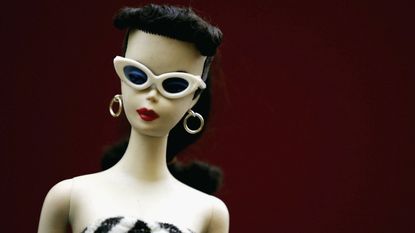Barbie: from problematic toy to feminist icon?
She may have exacerbated negative body image issues among girls but Barbie also offered a diverse range of career choices

Greta Gerwig’s blockbuster film “Barbie” has brought the legacy of the popular yet controversial doll back into the limelight.
With the release of the film, Gerwig has made history: “Barbie” took $377 million (£294 million) at the box office on its opening weekend around the world, making it the biggest debut ever for a film directed by a woman.
The film’s subject, the iconic doll played with by generations of children, has been the subject of both adoration and hand-wringing for decades.
Subscribe to The Week
Escape your echo chamber. Get the facts behind the news, plus analysis from multiple perspectives.

Sign up for The Week's Free Newsletters
From our morning news briefing to a weekly Good News Newsletter, get the best of The Week delivered directly to your inbox.
From our morning news briefing to a weekly Good News Newsletter, get the best of The Week delivered directly to your inbox.
Impossible proportions
Since the first doll was released by Mattel co-founder Ruth Handler in 1959, it has come under criticism for its impossible body proportions. Based on a German Lilli doll, typically gifted to men at bachelor parties, Barbie was “one of the first children’s toys to have breasts” alongside her “tiny waist and long legs”, said Stylist.
When student Galia Slayen recreated the doll in 2007, using measurements as if she were a real person, she found that Barbie would be 6ft tall, weigh 110lb, and have a 39-inch chest and an 18-inch waist.
Her unrealistic body size and representation as white, blonde and thin, means Barbie has frequently been blamed for contributing to negative body image among young girls. A 2006 study suggested that girls aged six to eight who played with Barbie dolls experienced higher levels of body dissatisfaction than girls who played with dolls with fuller figures.
‘An avatar for our wildly imaginative tendencies’
But despite the frequently cited negative connotations of Barbie dolls, what is often overlooked is how her “plastic-ness, her financial accessibility, her generic quality” means Barbie has been a canvas for imagination and creativity for generations of children, said Sarah Seltzer in Time magazine.
For decades, Barbie has been “an avatar for our most violent, strange and wildly imaginative tendencies” as children have “tied up their Barbies, dismembered them, acted out conflicts” and even “held orgies, too”. But whether as children we “revered her or destroyed her or both”, Barbie has been “subsumed into our own ideas about how to play”.
The doll “provided an easy way for kids, mostly girls, alone and in groups, to control their own narratives”, continued Seltzer. In that way, “she made the idea of adulthood, and womanhood, something younger girls could try on and experiment with, or simply fire down the hallway like a blonde torpedo”.
Barbie’s ‘proto-feminist’ messaging
Barbie’s “proto-feminist” messaging has been there from the very beginning, argued M.G. Lord in the Los Angeles Times, although many second-wave feminists are unlikely to agree. With her “unabashedly sexy body, no husband and a self-supporting job”, the first iterations of Barbie appear almost to have “preached the gospel of Helen Gurley Brown’s 1962 book ‘Sex and the Single Girl,’ an anti-marriage manifesto and an argument for women’s financial and sexual autonomy”, said Lord.
Barbie has evolved with the times, and in recent years Mattel has released a diverse range of Barbies as well as made changes to her body to address persistent criticisms – possibly partly in response to the emergence of fourth-wave feminism and its embrace of intersectionality and body positivity.
It is curious then that Mattel has remained reluctant to label Barbie as a feminist. “In Barbie’s world, however, objects speak louder than words,” said Lord. With her “vast array of ethnicities and body types” as well as “professions and personas” it is clear that Barbie is a “strong, independent woman”. Perhaps Mattel simply “balk at stating the obvious”.

Continue reading for free
We hope you're enjoying The Week's refreshingly open-minded journalism.
Subscribed to The Week? Register your account with the same email as your subscription.
Sign up to our 10 Things You Need to Know Today newsletter
A free daily digest of the biggest news stories of the day - and the best features from our website
Sorcha Bradley is a writer at The Week and a regular on “The Week Unwrapped” podcast. She worked at The Week magazine for a year and a half before taking up her current role with the digital team, where she mostly covers UK current affairs and politics. Before joining The Week, Sorcha worked at slow-news start-up Tortoise Media. She has also written for Sky News, The Sunday Times, the London Evening Standard and Grazia magazine, among other publications. She has a master’s in newspaper journalism from City, University of London, where she specialised in political journalism.
-
 6 tips to shop online safely this holiday season
6 tips to shop online safely this holiday seasonThe Explainer Lower the chances of credit card fraud spoiling your holidays
By Becca Stanek, The Week US Published
-
 The daily gossip: Anya Taylor-Joy leads epic 'Furiosa' trailer, Felicity Huffman felt she 'had to break the law' in college admissions scandal, and more
The daily gossip: Anya Taylor-Joy leads epic 'Furiosa' trailer, Felicity Huffman felt she 'had to break the law' in college admissions scandal, and moreThe daily gossip: December 1, 2023
By Brendan Morrow, The Week US Published
-
 What's Qatar's role in the Middle East conflict?
What's Qatar's role in the Middle East conflict?Today's Big Question Doha hosts both Hamas and a U.S. military base. That puts it at the center of the conflict in Gaza.
By Joel Mathis, The Week US Published
-
 Top Gear off air: how safe are UK film sets?
Top Gear off air: how safe are UK film sets?Talking Point Three-quarters of film and TV crew felt safety had been compromised at work in industry survey
By Julia O'Driscoll, The Week UK Published
-
 Netflix's real-life Squid Game: 'reality epic' or 'shoddy knock-off'?
Netflix's real-life Squid Game: 'reality epic' or 'shoddy knock-off'?Talking Point 456 players battle it out for the biggest prize pot in reality TV history
By The Week UK Published
-
 Christmas 2023 gifts for kids: top 20 toys of the year
Christmas 2023 gifts for kids: top 20 toys of the yearIn Pictures The Toy Retailers Association has unveiled the DreamToys Christmas wish list
By Mike Starling, The Week UK Published
-
 Sponsored weddings: a tradition for the Instagram generation
Sponsored weddings: a tradition for the Instagram generationTalking Point Brides and grooms are cashing in on brand deals to help cut costs
By Julia O'Driscoll, The Week UK Published
-
 France bans vegan ‘steaks’ and ‘ribs’
France bans vegan ‘steaks’ and ‘ribs’Talking Point French farmers and meat producers have long argued terms like ‘vegan sausage’ confuse customers
By Sorcha Bradley Published
-
 Are public marriage proposals getting out of hand?
Are public marriage proposals getting out of hand?Talking Point Previously private moment is ‘becoming a public event’ as companies cash in
By Chas Newkey-Burden Published
-
 Dogs in public places: paw form or about time?
Dogs in public places: paw form or about time?Talking Point Canine pets are being welcomed into UK churches, restaurants and even cinemas
By Sorcha Bradley Published
-
 Bradley Cooper, Leonard Bernstein and performing in ‘Jewface’
Bradley Cooper, Leonard Bernstein and performing in ‘Jewface’Talking Point Actor accused of antisemitism for playing Jewish composer with fake nose in upcoming Netflix biopic
By Harriet Marsden Published










